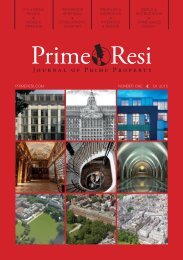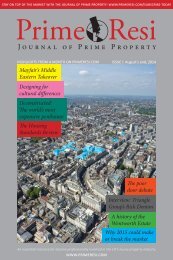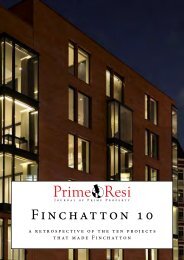Savills 12 Cities Report
Live/Work Index
Live/Work Index
Create successful ePaper yourself
Turn your PDF publications into a flip-book with our unique Google optimized e-Paper software.
2<br />
welcome<br />
<strong>Cities</strong> on<br />
the move<br />
Understanding the real estate markets of our <strong>12</strong> cities<br />
means getting to know their physical natures and<br />
personalities as much as their pricing regimes. Each<br />
city contains numerous layers of infrastructure that<br />
help to create city character. In our last issue we started to<br />
examine one aspect of this infrastructure – street patterns and<br />
population densities of each city. In this issue, we have put the<br />
public transport systems of our cities under the microscope.<br />
Although just one aspect of a city’s personality, these arteries<br />
play a significant role in determining the way that people interact<br />
and how they can use a city.<br />
The extent, speed and cost of transport infrastructure can<br />
dictate very different lifestyles for citizens and shape the longerterm<br />
economy of a city, as well as affecting environmental health<br />
through factors such as air pollution, walkability and noise.<br />
Sometimes, lack of affordable transport creates long and difficult<br />
journeys to work and play. In other instances, good transport can<br />
shrink a city by putting people in touch with far-flung<br />
neighbourhoods and disparate workplaces, bringing them<br />
together and enabling a city to function at its full potential.<br />
As we turn our eyes toward 2020 and ponder the future<br />
trends that will shape our world cities, the legacy of past<br />
infrastructure investments will either cloud the horizon or<br />
brighten it. Those responsible for shaping cities now should be<br />
aware of how their strategies will affect urban life in the future.<br />
The cities that have turned their backs on walkable and intense<br />
streetscapes, common to most pre-automobile cities across the<br />
world, may find that compensating for this loss comes at great<br />
financial, human and environmental cost. There will be additional<br />
pressures on transit systems. The cost and adequacy of these<br />
could determine a city’s longer-term prosperity.<br />
The rest of this report looks at the shorter term. It examines<br />
how new forces have changed the ranking of real estate costs<br />
and values in our cities. It also shows what different economic,<br />
geopolitical and natural events have occurred over the time that<br />
we have been monitoring these markets, and identifies what<br />
factors may continue to shape them in the near future.<br />
‘Lack of<br />
affordable<br />
transport<br />
creates long<br />
and difficult<br />
journeys<br />
to work<br />
and play’<br />
YOLANDE BARNES<br />
Director, <strong>Savills</strong><br />
World Research<br />
ybarnes@savills.com<br />
Twitter: @Yolande_Barnes<br />
H2 2014<br />
savills.com







